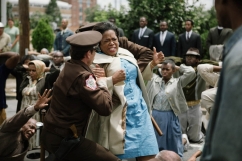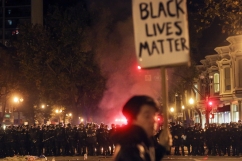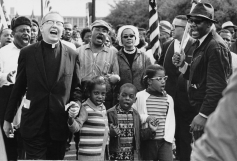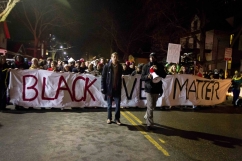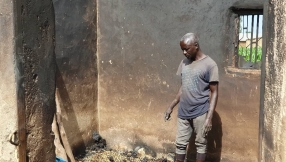Last Saturday, an unarmed black man was shot five times by a white police officer in North Charleston, South Carolina, in an incident that is becoming frighteningly familiar.
Walter Scott, a 50-year-old father of four, was fatally shot by officer Michael Slager, 33, who has now been charged with his murder. Footage caught by a witness shows a brief altercation between Scott and Slager before Scott runs, and Slager shoots at him eight times with a handgun from a distance of at least 15 feet. Scott, who received five bullets to the back, died at the scene. He had been stopped because of a broken tail light on his car and was not carrying any weapons.
The witness, Feidin Santana, told NBC News that there was a struggle between Slager and Scott before he began recording. "They were down on the floor," he said. "I remember the police [officer] had control of the situation. He had control of Scott. And Scott was trying just to get away from the Taser. I heard the sound of the Taser – Scott had been Tased before I started recording."
About one minute in to the footage, after Scott has been shot, Slager is seen going back to the position he shot from, picking something up, and dropping it next to Scott's body. There has been speculation that it was the stun gun, which Slager maintains Scott had wrestled from him.
Scott joins a list of recent victims of police killings that have sparked outrage across the US. Riots spread following the death of 18-year-old African-American Michael Brown in Ferguson, Missouri, last August. A damning report by the US Department of Justice later found that racial discrimination against black minorities was prevalent among the city's police force.
Two further separate killings, those of 22-year-old John Crawford and 12-year-old Tamir Rice, both African-Americans in Ohio, occurred when police mistook toy guns for real ones, and forced the issue of police brutality and racism into the open. Speaking on the 50th anniversary of Bloody Sunday in Selma, Alabama, last month, President Obama declared: "our march is not yet finished".
Estimates vary as to the number of people killed by police officers in the US, though website Mapping Police Violence puts it at 1,148 people in 2014. Of that figure, 304 were black – one every 29 hours. At least 100 of them were unarmed.
According to activists, the numbers are increasing. 36 black people were killed by police in March 2015 alone, a 71 per cent increase from the previous month. Almost half, 47 per cent, of those were unarmed.
A ProPublica analysis of killings by police published last year revealed that young black males are disproportionately at risk. Using federally collected data, researchers found that they were 21 times more likely to be shot dead by police than their white counterparts between 2010 and 2012. ProPublica reported: "One way of appreciating that stark disparity...is to calculate how many more whites over those three years would have had to have been killed for them to have been at equal risk. The number is jarring – 185, more than one per week."
Writing for the Independent, playwright, novelist and critic Bonnie Greer, says: "America has always had, still has, and may always have a grave and present fear and loathing of black men." Raised in Chicago, Greer says that she and other black children were taught to stay still and silent if stopped by police. "An explanation for whatever you're supposed to have done can be considered 'lip' – defiance; and a sudden move for your identification – well, that can get you killed. And that's just what little girls are told," she writes.
"Little boys – and it starts young – are told that if you're in a car, to put your hands on the top of the steering wheel the minute a cop pulls you over. Any movement could cost you your life."
Christian activist Shane Claiborne has been vocal about the reality of racial bias and discrimination in the US. Following the report into Ferguson, he said on Twitter that the "contagion of racism...has infected the police dept & courts", and has encouraged campaigners to engage in non-violent protest.
"Many of the worst pits of oppression have later become the brightest beacons of hope. Some of the worst moments of injustice have sparked some of the greatest movements for justice," he wrote in a blog post last September.
"And those places known for acts of evil later inspire the world towards freedom a generation later – out of these places rise up people like Nelson Mandela and Rosa Parks."
Claiborne recently spent time with David Couper, formerly a police chief and now a pastor. Writing on the Red Letter Christians website, Couper calls for an end to police killings of unarmed people.
According to the American constitution, police can shoot a suspect in certain circumstances of self-defence, or if they believe the suspect poses a significant physical danger to others. But "While the law may currently protect a police officer who takes the life of a threatening, unarmed person, it is not what I would call good police work," Couper says.
"Good police work manages conflict, de-escalates tense situations, reduces the threat of violence, and saves lives. Our nation's police should be guardians of our way of life, controlled in their use of force, and care for those who are in distress or in need of help."
The use of deadly force "conflicts with the values we hold with regard to the sanctity of human life, dignity of the human person, and the duty to provide care – especially to those who are exhibiting signs of mental illness," he concludes.
"It is wrong and we, as citizens, have every right to expect our police will conform to our wishes to preserve life."










